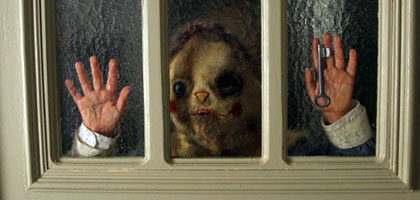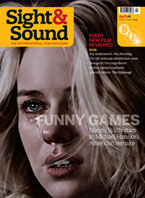The young and the damned
Film of the month: The Orphanage

J.A. Bayona's feature debut 'The Orphanage' uses the conventions of horror and ghost stories to explore Spain's need to face up to its buried history. By Maria Delgado
The opening credits of J.A. Bayona's debut feature emerge from wallpaper peeled away to reveal names concealed underneath. This is a portrait of a world beyond surface realities, of secrets and lies, and of the tortuous links between love and psychosis. Characters are forever looking behind hidden doors, rummaging in dusty sheds and searching remote caves to piece together the clues scattered before them. And The Orphanage draws on J.M. Barrie's Peter Pan and Henry James' The Turn of the Screw to indicate how the failure to allow children to grow up can have devastating consequences.
Bayona's film is structured in two halves. The first is dominated by Simón (Roger Príncep), who arrives with his mother Laura and father Carlos at the orphanage Laura lived in as a child and now wants to turn into a home for children with special needs. The latest in Spanish cinema's long line of wide-eyed children whose penetrating gazes probe the unspoken rules of the status quo, Simón most obviously recalls Ana Torrent, who played the spirited protagonists of Víctor Erice's The Spirit of the Beehive (1973) and Carlos Saura's Raise Ravens (1975).
Like The Spirit of the Beehive, The Orphanage unfolds in isolated surroundings where gothic fictions are interwoven with the characters' daily lives; like Raise Ravens it features a child who feels a connection with the dead. Geraldine Chaplin, the ghost-mother of Raise Ravens, plays the psychic Laura consults following Simón's disappearance to uncover the secrets of the former orphanage. Even as Saura's muse during the late 1960s and early 1970s Chaplin was always an outsider, an androgynous being whose waif-like beauty provided an alternative to the image of womanhood sanctioned under Franco. Almodóvar capitalised on her edgy foreignness in casting her as the eccentric dance teacher in Talk to Her and Bayona builds on these associations in using her as the means through which Laura begins her journey into the orphanage's murky past.
Belén Rueda (who played the lawyer Julia in The Sea Inside) gives a luminous performance as the grief-stricken mother prepared to go to any lengths to find out what has happened to her child. Sergio G. Sánchez's script (which won the Goya for Best Original Screenplay) remains focused on her unresolved grief and expertly posits both a psychological and paranormal explanation for the evolving action. For the most part the film relies on implication and evocation: disembodied voices and footsteps, a chilling masked child and Laura's gradual withdrawal into the inner recesses of the house as she rejects the voice of reason represented by her kindly but ineffectual husband and the down-to-earth police psychologist.
Bayona exploits the tropes of horror and the classic ghost story but only once does he introduce a moment of gore, with a terrifying flash of a massacred dead face. The haunted house, mysterious lights under the door and noises from the bathroom all disturb the vulnerable Laura and maintain a powerful sense of menace and dread. The unstable social worker Benigna recalls the nanny from The Omen (1976), Laura herself evokes the protagonists of Nicolas Roeg's Don't Look Now (1973) and Alejandro Amenábar's The Others (2001) and the labyrinthine house and its environs bring to mind Guillermo del Toro's The Devil's Backbone (2001) and Pan's Labyrinth (2006). Del Toro is the film's co-producer and Bayona's debt to the Mexican master of horror is evident in the compositions and score, though his visual landscape is less comic-book-meets-Goya and more shadows and supernatural suggestion.
The Orphanage operates within a female world where women search for, mourn and avenge their lost boys. But as in The Devil's Backbone and Pan's Labyrinth, the focus is on children damaged by the ravages of dictatorship in both its domestic and institutional forms. The ghosts of Laura's childhood companions, shown during the course of the film to have been murdered by Benigna for their role in her disabled son's 'accidental' demise, are caught up in a revenge tragedy that plays out as an ongoing cycle of lives ruined by past mistakes that can never be openly discussed. The chain of events that leads to the death of all the children stems from a failure to accept difference, with Tomás victimised because he is not like the others. And the horrors unleashed deliver a pertinent lesson for a country where the consequences of fratricidal conflict remain all too visible.
While The Orphanage does not refer directly to Spain's Civil War or to the Franco regime in the manner of The Devil's Backbone or Pan's Labyrinth, the film's resonance for a nation still coming to terms with its recent history may in part explain its commercial success as the top-grossing Spanish box-office hit of 2007, outperforming such Hollywood blockbusters as Shrek the Third and Pirates of the Caribbean: At World's End. After much debate, Spain's Law of Historical Memory was finally passed by José Luis Rodríguez Zapatero's socialist government late last year, with the result that the bodies of between 30,000 and 150,000 civilians who opposed the right-wing Nationalists during the Civil War and its aftermath can be exhumed from the mass graves in which they are believed to lie. The Orphanage adeptly explores the legacy of a buried past. Only by returning to the orphanage can Laura come to terms with what happened to her contemporaries, while the coal shed in which the children's ashes rest is a reminder that the tentacles of the Civil War found their way into every corner of the country.
The wave of recent Spanish-language films invoking the Civil War and its consequences, whether in revisiting victims of Francoism (as in Manuel Huerga's biopic of anarchist Salvador Puig Antich) or in addressing the need to come to terms with obscured events (as in Ventura Pons' Barcelona, A Map), point to the problems of conceiving truth as a single entity. The advice dispensed in The Orphanage by Chaplin's psychic - "seeing is not believing, it's the other way around" - provides a necessary warning about the dangers of dismissing what cannot be easily explained. And The Orphanage carries this through into its mise en scène, refusing ostentatious sound cues or lurid incidental music and instead encouraging the viewer to negotiate between the realistic and the fantastic in probing the film's shadows.
This is a movie whose power and emotional pitch lie in the understated: the discreet performances, the lack of special effects, the laconic script. Yes, one can quibble over an unnecessary prologue, a drawn-out séance and a sentimental final sequence, but these are minor flaws in a poignant film that looks to the past and the world beyond to illuminate the realities of the present.


